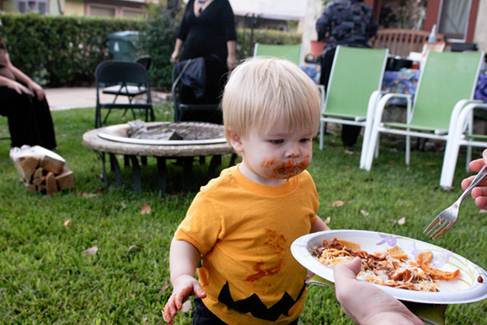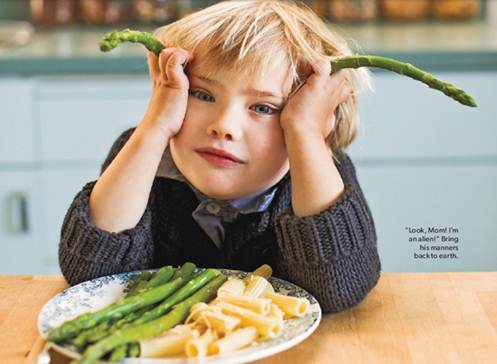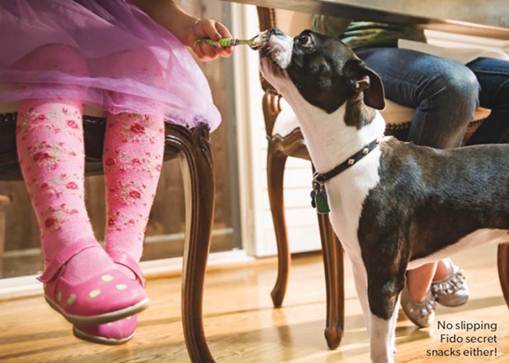Put an end to mealtime oh-no-you-don’ts and raise kids who
will be welcome at any table.
In the short time it takes for me to put all the dishes out
and join my children at the table, my 7-year-old will already have given new
meaning to the words graphic tee. Ketchup smeared across the front of his shirt
is never a surprise, nor is his saucy mouth being wiped across his sleeve.
Let’s face it: Every child is a dinner-table nightmare until taught some
manners, but with our often frantic lives it’s just not happening. “We’re
eating in shifts or in the car. The opportunities to sit down to a meal together,
where manners are taught and practiced, are getting lost,” says Amber
Tankersley, Ph.D., associate professor of early-childhood development at
Pittsburg State University, in Kansas. If you’ve had enough of the burping,
slurping, and sloppy stains, dig into these genius ideas for taming rude table
manners – and you won’t have to sweat the big holiday meals ahead.
The goal: using a napkin, not his shirt, to wipe hands
“When a child constantly wipes messy hands on his clothes,
it’s probably an unconscious move,” says Christine Carter, Ph.D., a parent
coach and author of Raising Happiness. “He just wants quick relief from the
food gunk.”

“When a child
constantly wipes messy hands on his clothes, it’s probably an unconscious move”
How to get there: Start by offering a reward that your child
will be stoked about. “When one of my sons was into washable tattoos, I’d let
him choose a cool tattoo for his arm if he could get through dinner without
using his sleeve,” says family physician Deborah Gilboa, M.D., founder of
AskDoctorG.com and mom of four boys ages 5 to 11. Or begin a family “Golden
Napkin Award.” Bestow a gold-colored (yellow will do) paper napkin on the
member who goes a week without any admonishments.
Here’s another trick you may not have tried: shirtless
dinners! His sleeve or other favorite wiping spot is no longer available, so
he’ll need to reach for that napkin, notes Dr. Gilboa. If he goes for his pants
instead, take those off too! (Obviously this is something you do only at home
and until your child get with the program.)
The goal: giving compliments, not “yucks,” to the chef
Picky eating is epidemic among young kids and considering a
cook’s feelings doesn’t come naturally, so it’s hard for them to hold back on
sharing exactly what they are thinking. “Social graces aren’t automatic, so you
have to model and teach those nicer ways to express opinions,” says Dr.
Tankersley.
How to get there: “Tell kids as young as 3 or 4 years old
that saying ‘eeww’ or ‘ick’ about the menu can hurt the feelings of the person
who cooked it,” says Dr. Gilboa. You don’t want them to lie but you do want
them to learn words that sting less. “‘No thanks,’ ‘Maybe I’ll try it next
time,’ or ‘Sorry, it’s not that yummy to me’ are all more polite than ‘Gross!’”
suggests Dr. Gilboa, adding that “We taught our kids to use the code word
interesting for describing a food they don’t like.”

“Look, Mom! I’m an
alien!” Bring his manners back to earth
The goal: asking nicely for food to be passed
“When children see something they want, their first instinct
is to reach for it,” says Ashley Harlow, Ph.D., a psychologist at Children’s
Hospital and Medical Center, in Omaha.
How to get there: “Set boundaries of personal space,” says
Dr. Harlow. “Put large place mats below each place setting, explaining that
arms and other body parts shouldn’t extend beyond the borders.” Creating these
fences – call them “superhero force fields” for fun – requires kids to use
their magic words when they want something since they can’t reach beyond them.
(They also help cut down on spills!) Build in practice by passing dishes
family-style in manageable-size bowls.

No slipping Fido
secret snacks either!
The goal: chewing with her mouth closed
Little ones have a tendency to take huge bites, which
unfortunately means that what they’re chewing stays in full view, laments Cindy
Post Senning, Ed. D., codirect or of The Emily Post Institute, in Burlington,
Vermont.
How to get there: When you spot a monster-size spoon-or
forkful headed for your kid’s mouth, intercept it before it gets there: “Whoa,
that’s too much! Why don’t you put half of that back on your plate?” Too late?
Explain that you can’t understand what she’s saying if she tries to talk with a
full mouth. “Assure excited kids who are worried about missing their turn to
speak that once they chew and swallow, you’ll be ready to listen,” says Dr.
Senning. You might start a family signal where the person with a full mouth
sticks up an index finger when she wants everyone to stay on-topic until she
can talk.
The goal: making conversation, not burps, at the table
Kids like to belch because, well, it’s completely inappropriate
and, as a result, hilarious; it usually gets a lot of attention – positive (from
siblings and friends) and negative (from parents). “Kids love behaviors that
get a big reaction,” says Dr. Harlow.

Kids like to belch
because, well, it’s completely inappropriate and, as a result, hilarious; it
usually gets a lot of attention
How to get there: Your mission: Be the most boring audience
ever. Ignore the burping and even talk right over it – about the weather, your
job, or decorating the house (a snooze fest for kids). If the other kids can’t
help but giggle, put your burper in a time-out away from the table or else
he’ll keep on going, suggests Dr. Harlow.